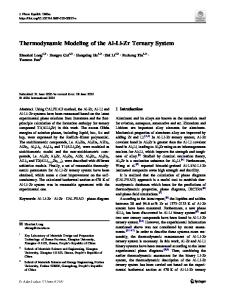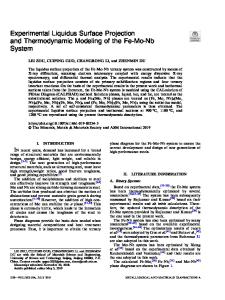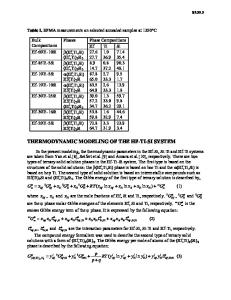Thermodynamic modeling of the nickel-lead-tin system
- PDF / 350,947 Bytes
- 14 Pages / 612 x 792 pts (letter) Page_size
- 36 Downloads / 464 Views
I. INTRODUCTION
NICKEL- based metallization schemes, ranging from pure Ni to Cu-Ni, Ni-Pd, Ni-P, and Ni-V alloys, are either used or currently being developed for microelectronics packaging.[1,2] Even though Cu is the most commonly used solderable surface finish in printed circuit boards, Ni or a suitable Ni-based alloy is considered to be an excellent candidate for preventing excessive intermetallic formation. It is well known that the solders containing Sn react with Ni to form intermetallic(s) at the solder/metallization interface both during processing (or device fabrication) and in service. However, the rate of interfacial reaction is a strong function of processing and service temperatures and metallization and solder compositions. Often the interfacial reaction is exploited/controlled to obtain optimum properties of the joints. In the case of electronic packaging, it is very important to understand and control the interfacial microstructure formed due to the reaction between Ni and Pb-Sn or Pbfree solders. Various phenomena governed by thermodynamic forces, such as interfacial reaction leading to the formation of new phase(s), wetting, and dewetting are of fundamental and practical interest to improve the reliability of microelectronic packaging. The strength and interfacial properties of the solder joints are determined by the interfacial microstructure. The evolution of the interfacial microstructure in solder joints is governed by the diffusion path during processing and in service. Even though the semiconductor industry uses a wide variety of complex metallization schemes, a thermodynamic description of the Ni-Pb-Sn system is needed to understand the interfacial microstructure of the real solder joints, since, in many cases, the metallization scheme contains Ni. Furthermore, the design of new metallization scheme(s) to control the interfacial microstructure and to improve the quality of solder joints is the cornerstone of advanced electronic packaging technology. The Pb-Sn phase diagram is well studied, and, due to its simplicity, the thermodynamic description of the system G. GHOSH, Research Assistant Professor, is with the Department of Materials Science and Engineering, Robert R. McCormick School of Engineering and Applied Science, Northwestern University, Evanston, IL 60208-3108. Manuscript submitted October 16, 1998. METALLURGICAL AND MATERIALS TRANSACTIONS A
exists in the literature.[3,4] The experimental phase-diagram data of Ni-Pb and Ni-Sn systems have been assessed by Nash[5] and Nash and Nash,[6] respectively. However, a comprehensive thermodynamic modeling of these two systems is still lacking. The objectives of this study are twofold: (1) to derive a set of self-consistent thermodynamic parameters to describe the phase equilibria in the Ni-Pb and Ni-Sn systems and (2) to calculate the Ni-Pb-Sn isothermal sections. Since the experimental Ni-Pb-Sn ternary-phase diagrams are not known, a convenient way to establish the phase relations is by calculations based on thermodynamic principles. Besi
Data Loading...











